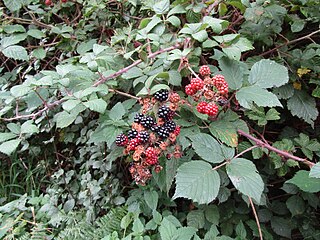
Genus is a taxonomic rank above species and below family as used in the biological classification of living and fossil organisms as well as viruses. In binomial nomenclature, the genus name forms the first part of the binomial species name for each species within the genus.

Rubus is a large and diverse genus of flowering plants in the rose family, Rosaceae, subfamily Rosoideae, with over 1,350 species, commonly known as brambles.

Naperville is a city in DuPage and Will counties in the U.S. state of Illinois. It is a southwestern suburb of Chicago located 28 miles (45 km) west of the city on the DuPage River. As of the 2020 census, its population was 149,540, making it the state's fourth-most populous city.

Mergus is the genus of the typical mergansers fish-eating ducks in the subfamily Anatinae. The genus name is a Latin word used by Pliny the Elder and other Roman authors to refer to an unspecified waterbird.

Cheloniidae is a family of typically large marine turtles that are characterised by their common traits such as, having a flat streamlined wide and rounded shell and almost paddle-like flippers for their forelimbs. They are the only sea turtles to have stronger front limbs than back limbs. The six species that make up this family are: the green sea turtle, loggerhead sea turtle, olive ridley sea turtle, hawksbill sea turtle, flatback sea turtle and the Kemp's ridley sea turtle.

The 200 metres, or 200-meter dash, is a sprint running event. On an outdoor 400 metre racetrack, the race begins on the curve and ends on the home straight, so a combination of techniques is needed to successfully run the race. A slightly shorter race, called the stadion and run on a straight track, was the first recorded event at the ancient Olympic Games. The 200 m places more emphasis on speed endurance than shorter sprint distances as athletes predominantly rely on anaerobic energy system during the 200 m sprint. Similarly to other sprint distances, the 200 m begins from the starting blocks. When the sprinters adopt the 'set' position in the blocks they are able to adopt a more efficient starting posture and isometrically preload their muscles. This enables them to stride forwards more powerfully when the race begins and start faster.

60 metres hurdles is a distance in hurdling which is generally run in indoor competitions. It is equivalent with the first 5 hurdles of a standard outdoor hurdle race. The current women's and men's world records are 7.65 seconds and 7.27 seconds, respectively.
Ganorhynchus is an extinct genus of prehistoric lungfish from the Devonian period. Fossils were found in Mansfield, Pennsylvania.

Eels are ray-finned fish belonging to the order Anguilliformes, which consists of eight suborders, 20 families, 164 genera, and about 1000 species. Eels undergo considerable development from the early larval stage to the eventual adult stage and are usually predators.
Duddingtonia is a genus of fungi in the family Orbiliaceae comprising only the species Duddingtonia flagrans.

Trichothecium roseum is a fungus in the division Ascomycota first reported in 1809. It is characterized by its flat and granular colonies which are initially white and develop to be light pink in color. This fungus reproduces asexually through the formation of conidia with no known sexual state. Trichothecium roseum is distinctive from other species of the genus Trichothecium in its characteristic zigzag patterned chained conidia. It is found in various countries worldwide and can grow in a variety of habitats ranging from leaf litter to fruit crops. Trichothecium roseum produces a wide variety of secondary metabolites including mycotoxins, such as roseotoxins and trichothecenes, which can infect and spoil a variety of fruit crops. It can act as both a secondary and opportunistic pathogen by causing pink rot on various fruits and vegetables and thus has an economical impact on the farming industry. Secondary metabolites of T. roseum, specifically Trichothecinol A, are being investigated as potential anti-metastatic drugs. Several agents including harpin, silicon oxide, and sodium silicate are potential inhibitors of T. roseum growth on fruit crops. Trichothecium roseum is mainly a plant pathogen and has yet to show a significant impact on human health.
Gliomastix is a genus of fungi belonging to the family Bionectriaceae.

Triphragmium is a genus of fungi belonging to the family Phragmidiaceae.









